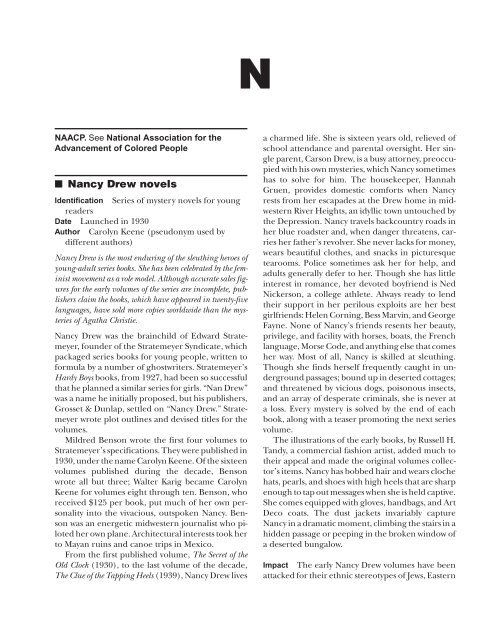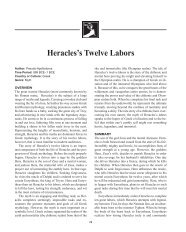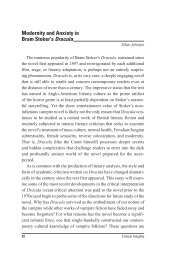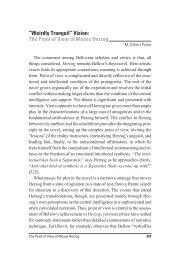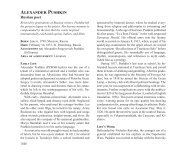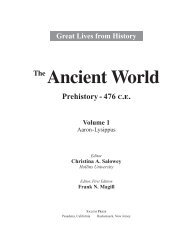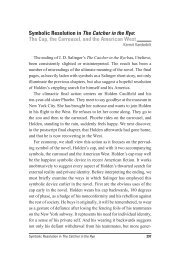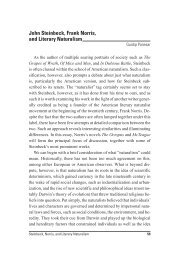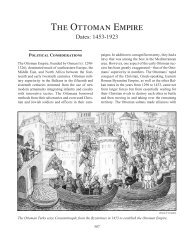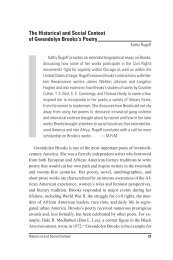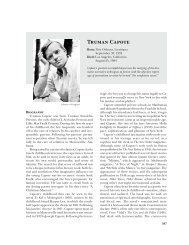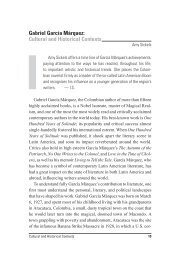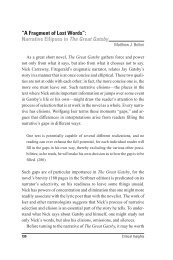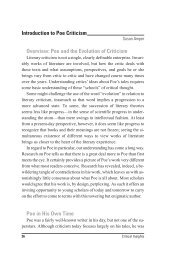NAACP. See National Association for the Advancement - Salem Press
NAACP. See National Association for the Advancement - Salem Press
NAACP. See National Association for the Advancement - Salem Press
You also want an ePaper? Increase the reach of your titles
YUMPU automatically turns print PDFs into web optimized ePapers that Google loves.
<strong>NAACP</strong>. <strong>See</strong> <strong>National</strong> <strong>Association</strong> <strong>for</strong> <strong>the</strong><br />
<strong>Advancement</strong> of Colored People<br />
■<br />
Identification Series of mystery novels <strong>for</strong> young<br />
readers<br />
Date Launched in 1930<br />
Author Carolyn Keene (pseudonym used by<br />
different authors)<br />
Nancy Drew is <strong>the</strong> most enduring of <strong>the</strong> sleuthing heroes of<br />
young-adult series books. She has been celebrated by <strong>the</strong> feminist<br />
movement as a role model. Although accurate sales figures<br />
<strong>for</strong> <strong>the</strong> early volumes of <strong>the</strong> series are incomplete, publishers<br />
claim <strong>the</strong> books, which have appeared in twenty-five<br />
languages, have sold more copies worldwide than <strong>the</strong> mysteries<br />
of Agatha Christie.<br />
Nancy Drew was <strong>the</strong> brainchild of Edward Stratemeyer,<br />
founder of <strong>the</strong> Stratemeyer Syndicate, which<br />
packaged series books <strong>for</strong> young people, written to<br />
<strong>for</strong>mula by a number of ghostwriters. Stratemeyer’s<br />
Hardy Boys books, from 1927, had been so successful<br />
that he planned a similar series <strong>for</strong> girls. “Nan Drew”<br />
was a name he initially proposed, but his publishers,<br />
Grosset & Dunlap, settled on “Nancy Drew.” Stratemeyer<br />
wrote plot outlines and devised titles <strong>for</strong> <strong>the</strong><br />
volumes.<br />
Mildred Benson wrote <strong>the</strong> first four volumes to<br />
Stratemeyer’s specifications. They were published in<br />
1930, under <strong>the</strong> name Carolyn Keene. Of <strong>the</strong> sixteen<br />
volumes published during <strong>the</strong> decade, Benson<br />
wrote all but three; Walter Karig became Carolyn<br />
Keene <strong>for</strong> volumes eight through ten. Benson, who<br />
received $125 per book, put much of her own personality<br />
into <strong>the</strong> vivacious, outspoken Nancy. Benson<br />
was an energetic midwestern journalist who piloted<br />
her own plane. Architectural interests took her<br />
to Mayan ruins and canoe trips in Mexico.<br />
From <strong>the</strong> first published volume, The Secret of <strong>the</strong><br />
Old Clock (1930), to <strong>the</strong> last volume of <strong>the</strong> decade,<br />
The Clue of <strong>the</strong> Tapping Heels (1939), Nancy Drew lives<br />
N<br />
a charmed life. She is sixteen years old, relieved of<br />
school attendance and parental oversight. Her single<br />
parent, Carson Drew, is a busy attorney, preoccupied<br />
with his own mysteries, which Nancy sometimes<br />
has to solve <strong>for</strong> him. The housekeeper, Hannah<br />
Gruen, provides domestic com<strong>for</strong>ts when Nancy<br />
rests from her escapades at <strong>the</strong> Drew home in midwestern<br />
River Heights, an idyllic town untouched by<br />
<strong>the</strong> Depression. Nancy travels backcountry roads in<br />
her blue roadster and, when danger threatens, carries<br />
her fa<strong>the</strong>r’s revolver. She never lacks <strong>for</strong> money,<br />
wears beautiful clo<strong>the</strong>s, and snacks in picturesque<br />
tearooms. Police sometimes ask her <strong>for</strong> help, and<br />
adults generally defer to her. Though she has little<br />
interest in romance, her devoted boyfriend is Ned<br />
Nickerson, a college athlete. Always ready to lend<br />
<strong>the</strong>ir support in her perilous exploits are her best<br />
girlfriends: Helen Corning, Bess Marvin, and George<br />
Fayne. None of Nancy’s friends resents her beauty,<br />
privilege, and facility with horses, boats, <strong>the</strong> French<br />
language, Morse Code, and anything else that comes<br />
her way. Most of all, Nancy is skilled at sleuthing.<br />
Though she finds herself frequently caught in underground<br />
passages; bound up in deserted cottages;<br />
and threatened by vicious dogs, poisonous insects,<br />
and an array of desperate criminals, she is never at<br />
a loss. Every mystery is solved by <strong>the</strong> end of each<br />
book, along with a teaser promoting <strong>the</strong> next series<br />
volume.<br />
The illustrations of <strong>the</strong> early books, by Russell H.<br />
Tandy, a commercial fashion artist, added much to<br />
<strong>the</strong>ir appeal and made <strong>the</strong> original volumes collector’s<br />
items. Nancy has bobbed hair and wears cloche<br />
hats, pearls, and shoes with high heels that are sharp<br />
enough to tap out messages when she is held captive.<br />
She comes equipped with gloves, handbags, and Art<br />
Deco coats. The dust jackets invariably capture<br />
Nancy in a dramatic moment, climbing <strong>the</strong> stairs in a<br />
hidden passage or peeping in <strong>the</strong> broken window of<br />
a deserted bungalow.<br />
Impact The early Nancy Drew volumes have been<br />
attacked <strong>for</strong> <strong>the</strong>ir ethnic stereotypes of Jews, Eastern
660 ■ Nation of Islam The Thirties in America<br />
Europeans, and African Americans. Later editions<br />
attempted to correct <strong>the</strong>se problems, while making<br />
Nancy more conventional, if less interesting. Collectors<br />
prefer <strong>the</strong> original volumes. Nancy’s adventures<br />
in River Heights helped readers escape <strong>the</strong> deprivations<br />
of <strong>the</strong> Depression and rumors of war. The fact<br />
that teachers and librarians found <strong>the</strong> books objectionable<br />
only added to <strong>the</strong>ir popularity. Nancy enabled<br />
young girls to believe <strong>the</strong>y too could lead lives<br />
of achievement and adventure. Among <strong>the</strong> many accomplished<br />
women who have acknowledged <strong>the</strong><br />
early influence of Nancy Drew are politician Hillary<br />
Clinton, opera singer Beverly Sills, television journalist<br />
Barbara Walters, <strong>for</strong>mer First Lady Laura<br />
Bush, and <strong>the</strong> first three women appointed to <strong>the</strong><br />
U.S. Supreme Court.<br />
Allene Phy-Olsen<br />
Fur<strong>the</strong>r Reading<br />
Mason, Bobbie Ann. The Girl Sleuth: A Feminist Guide.<br />
Old Westbury, N.Y.: The Feminist <strong>Press</strong>, 1975.<br />
Plunkett-Powell, Karen. The Nancy Drew Scrapbook.<br />
New York: St. Martin’s <strong>Press</strong>, 1993.<br />
Rehak, Melanie. Girl Sleuth: Nancy Drew and <strong>the</strong><br />
Women Who Created Her. New York: Harcourt, 2005.<br />
<strong>See</strong> also African Americans; Anti-Semitism; Great<br />
Depression in <strong>the</strong> United States; Literature in <strong>the</strong><br />
United States; Recreation.<br />
■<br />
Identification American-based Muslim religious<br />
organization<br />
Date Founded in July, 1930<br />
Place Detroit, Michigan<br />
Established during a period of African American migration<br />
out of <strong>the</strong> South and growing economic disparities between<br />
<strong>the</strong> races, worsened by <strong>the</strong> Great Depression, <strong>the</strong> Nation<br />
of Islam represents an important strain of African<br />
American nationalism. It served <strong>the</strong> religious and political<br />
needs of many African Americans during <strong>the</strong> 1930’s by espousing<br />
freedom and justice <strong>for</strong> black people, and it would<br />
become one of <strong>the</strong> most important African American institutions<br />
in later decades as well.<br />
The exact beginnings of <strong>the</strong> Nation of Islam (adherents<br />
call <strong>the</strong>mselves Muslims) are not clearly recorded.<br />
The founder, Wallace Dodd Fard (also<br />
known as Wallace Fard Muhammad), spread word of<br />
his variant of Islam through door-to-door sales in Detroit<br />
among dispossessed blacks, beginning in July,<br />
1930. Fard initially used <strong>the</strong> Bible to teach about Islam<br />
as <strong>the</strong> religion of black people in Asia and Africa,<br />
and eventually he introduced followers to <strong>the</strong><br />
Qur$3n, <strong>the</strong> holy book of Islam. At its inception, <strong>the</strong><br />
Nation of Islam held religious meetings in private<br />
homes. Within three years, as a result of <strong>the</strong> religion’s<br />
rapid growth, Fard was holding temple meetings<br />
in a hall and had established Muslim schools <strong>for</strong><br />
children in Detroit.<br />
Mainstream Muslims regard <strong>the</strong> Nation of Islam<br />
as a separatist Islamic sect. Fard’s religious doctrines<br />
were heavily infused with racial ideologies (though<br />
<strong>the</strong> exact racial lineage of Fard himself remains debated<br />
and unknown). Among its tenets, <strong>the</strong> Nation<br />
of Islam teaches that black people are <strong>the</strong> original<br />
humans and Caucasians <strong>the</strong> result of <strong>the</strong> workings of<br />
a mad scientist named Yakub. Likened to “devils,”<br />
white people, <strong>the</strong> Nation of Islam argued, were inferior<br />
to black people. Shortly after its founding, <strong>the</strong><br />
Nation of Islam attracted controversy <strong>for</strong> some of its<br />
more inflammatory racial teachings. Fard taught his<br />
followers that one could be ensured salvation<br />
through Mecca by sacrificing (murdering) four<br />
“white devils.” In 1932 and 1933, <strong>the</strong> Nation of Islam<br />
attracted much attention from <strong>the</strong> Detroit police<br />
over this tenet, and rumors of at least one sacrifice<br />
persist to this day, though <strong>the</strong> tenet is omitted from<br />
modern teachings.<br />
Fard disappeared from <strong>the</strong> organization sometime<br />
during 1933 or 1934. Speculation arose that he<br />
had been murdered. Historians have deemed this<br />
unlikely, but stories have circulated about his subsequent<br />
whereabouts <strong>for</strong> decades. Since 1931, Fard<br />
had been grooming a convert, Elijah Poole (who<br />
later was given a Muslim name, Elijah Muhammad),<br />
<strong>for</strong> ministry in <strong>the</strong> Nation of Islam. After Fard’s<br />
disappearance, Muhammad continued to preach<br />
throughout <strong>the</strong> United States, predominantly in <strong>the</strong><br />
North and in Washington, D.C., proselytizing according<br />
to <strong>the</strong> doctrine he had learned from Fard.<br />
These messages were passed down in written <strong>for</strong>m in<br />
The Supreme Wisdom (1957) and included <strong>the</strong> belief<br />
in one god (Allah), <strong>the</strong> holy Qur$3n, and <strong>the</strong> Bible.<br />
The Nation of Islam experienced internal fractures<br />
during this time and was threatened by outside attempts<br />
to weaken <strong>the</strong> organization, including ef<strong>for</strong>ts<br />
from <strong>the</strong> Communist Party USA and <strong>the</strong> Japanese.
The Thirties in America Nation of Islam ■ 661<br />
The first prophet of <strong>the</strong> Nation of Islam is shrouded in mystery: His national origins, his real name, and <strong>the</strong> circumstances<br />
of his 1934 disappearance are not fully known, but an FBI memorandum from Special Agent Edwin O.<br />
Raudsep, dated March 8, 1965 (approximately three decades after Fard’s death), rehearses <strong>the</strong> known facts about<br />
Fard at that time.<br />
[Wallace] Dodd arrived in <strong>the</strong> United States from<br />
New Zealand in 1913, settled briefly in Portland,<br />
Oregon. He married but abandoned his wife and<br />
infant son. He lingered in <strong>the</strong> Seattle Area as Fred<br />
Dodd <strong>for</strong> a few months, <strong>the</strong>n moved to Los Angeles<br />
and opened a restaurant at 803 W. Third<br />
Street as Wallace D. Ford. He was arrested <strong>for</strong><br />
bootlegging in January, 1926; served a brief jail<br />
sentence (also as Wallace D. Ford)—identified<br />
on record as white.<br />
On June 12, 1926, also as Ford, was sentenced<br />
to San Quentin <strong>for</strong> sale of narcotics at his restaurant;<br />
got 6-months to 6-years sentence—released<br />
from San Quentin May 27, 1929. Prison record<br />
lists him as Caucasian.<br />
After release, went to Chicago, <strong>the</strong>n to Detroit<br />
as a silk peddler. His customers were mostly Negro<br />
and he himself posed as a Negro. He prided<br />
himself as a biblical authority and ma<strong>the</strong>matician.<br />
When Elijah Muhammad (Poole) met him, he<br />
was passing himself off as a savior and claiming<br />
that he was born in Mecca and had arrived in <strong>the</strong><br />
U.S. on July 4, 1930.<br />
In 1933 <strong>the</strong>re was a scandal revolving about <strong>the</strong><br />
sect involving a “human sacrifice” which may or<br />
may not have been trumped up. At any rate, <strong>the</strong><br />
leader was arrested May 25, 1933, under <strong>the</strong> name<br />
Fard with 8 o<strong>the</strong>r listed aliases (W. D. Farrad,<br />
Wallace Farad, Walt Farrad, Prof. Ford, etc.). The<br />
official report says Dodd admitted that his teachings<br />
were “strictly a racket” and he was “getting all<br />
In 1942, Muhammad headquartered <strong>the</strong> Nation<br />
of Islam in Chicago and started <strong>the</strong> arduous task of<br />
rebuilding <strong>the</strong> membership, which had begun to<br />
dwindle during <strong>the</strong> latter half of <strong>the</strong> 1930’s. In <strong>the</strong><br />
1950’s, <strong>the</strong> organization gained public attention<br />
once again when Malcolm X took a position as its national<br />
spokesman, until he broke with <strong>the</strong> Nation of<br />
Who Was Wallace D. Fard?<br />
<strong>the</strong> money out of it he could.” He was ordered out<br />
of Detroit.<br />
[In a] newspaper article which appeared in <strong>the</strong><br />
San Francisco Examiner and <strong>the</strong> Los Angeles Examiner<br />
on July 28, 1963, reporter Ed Montgomery . . .<br />
claimed to have contacted Dodd’s <strong>for</strong>mer common<br />
law wife. . . . According to this account, Dodd<br />
went to Chicago after leaving Detroit and became<br />
a traveling suit salesman <strong>for</strong> a mail order tailer<br />
[sic]. In this position he worked himself across <strong>the</strong><br />
midwest and ultimately arrived in Los Angeles in<br />
<strong>the</strong> spring of 1934 in a new car and wearing flowing<br />
white robes. He tried to work out a reconciliation<br />
with <strong>the</strong> woman, but she would not agree to<br />
one. ...Hestayed in Los Angeles <strong>for</strong> two weeks,<br />
frequently visiting his son. Then he sold his car<br />
and boarded a ship bound <strong>for</strong> New Zealand<br />
where he said he would visit relatives.<br />
On Sunday, February 28, 1965, Ed Montgomery<br />
wrote a rehash of <strong>the</strong> above in which he said<br />
<strong>the</strong> Muslims claim “police and San Quentin<br />
Prison records dating back to <strong>the</strong> early 1920’s had<br />
been altered and that fingerprints identifying<br />
Farad as Dodd had been doctored.” Elijah<br />
Mohummad [sic] said he would have posted<br />
$100,000 reward “<strong>for</strong> any person who could prove<br />
Farad and Dodd were one and <strong>the</strong> same person.”<br />
Ten days later Muhammad’s office in Chicago was<br />
advised Farad’s common law wife and a blood relative<br />
were prepared to establish <strong>the</strong> truth of<br />
Farad’s identity. The $100,000 never was placed<br />
in escrow and <strong>the</strong> matter was dropped <strong>for</strong>thwith.<br />
Islam in 1964. Elijah Muhammad retained control<br />
of <strong>the</strong> organization until his death in 1975.<br />
Impact During a time of great economic and racial<br />
difficulty <strong>for</strong> nor<strong>the</strong>rn blacks, many of whom had<br />
found <strong>the</strong>ir prospects <strong>for</strong> economic and social<br />
equality little improved after migrating north from
662 ■ <strong>National</strong> <strong>Association</strong> <strong>for</strong> <strong>the</strong> <strong>Advancement</strong> of Colored People The Thirties in America<br />
<strong>the</strong> South, <strong>the</strong> Nation of Islam proved to be an important<br />
religious and political vehicle within <strong>the</strong> African<br />
American community. Initial memberships<br />
spread quickly after an ambiguous start in urban Detroit.<br />
A uniquely American version of Islam, <strong>the</strong> Nation<br />
of Islam had special resonance <strong>for</strong> racially and<br />
economically dispossessed African Americans in <strong>the</strong><br />
1930’s. The message of hope and equality espoused<br />
by <strong>the</strong> Nation of Islam became an important vein of<br />
African American nationalism throughout 1950’s<br />
and 1960’s.<br />
Sadie Pendaz<br />
Fur<strong>the</strong>r Reading<br />
Lee, Martha F. The Nation of Islam: An American Millenarian<br />
Movement. New York: Syracuse University<br />
<strong>Press</strong>, 1996.<br />
Lincoln, C. Eric. The Black Muslims in America. Grand<br />
Rapids, Mich.: Wm. B. Eerdmans, 1994.<br />
Muhammad, Elija. The Supreme Wisdom. 2 vols. Atlanta,<br />
Ga.: Messenger Elijah Muhammad Propagation<br />
Society, 1957.<br />
Walker, Dennis. Islam and <strong>the</strong> Search <strong>for</strong> African-<br />
American Nationhood: Elijah Muhammad, Louis<br />
Farrakhan, and <strong>the</strong> Nation of Islam. Atlanta, Ga.:<br />
Clarity <strong>Press</strong>, 2005.<br />
<strong>See</strong> also African Americans; Great Depression in<br />
<strong>the</strong> United States; Jim Crow segregation; Migrations,<br />
domestic; Religion in <strong>the</strong> United States.<br />
■<br />
Identification Civil rights advocacy organization<br />
Date Founded on February 12, 1909<br />
The <strong>National</strong> <strong>Association</strong> <strong>for</strong> <strong>the</strong> <strong>Advancement</strong> of Colored<br />
People (<strong>NAACP</strong>) began as a grassroots organization in response<br />
to increased violence against African Americans.<br />
Throughout its existence, <strong>the</strong> <strong>NAACP</strong> has worked primarily<br />
through <strong>the</strong> U.S. legal system in its campaign to help African<br />
Americans gain equal civil rights.<br />
The 1930’s were a turbulent time <strong>for</strong> race relations<br />
in <strong>the</strong> United States. The increased presence of African<br />
Americans in sou<strong>the</strong>rn cities resulted in heightened<br />
tension between <strong>the</strong> African Americans and<br />
Caucasians. As more and more African Americans<br />
moved north, <strong>the</strong>se tensions increased in nor<strong>the</strong>rn<br />
cities as well. The <strong>NAACP</strong>’s principal objective was to<br />
ensure <strong>the</strong> political, educational, social, and economic<br />
equality of all citizens of <strong>the</strong> United States, regardless<br />
of race. The organization used <strong>the</strong> democratic<br />
processes of lobbying and litigation in an<br />
ef<strong>for</strong>t to remove what it considered to be <strong>the</strong> three<br />
major evils of discrimination against African Americans—school<br />
segregation, lynching, and Jim Crow<br />
laws that legalized segregation in <strong>the</strong> South.<br />
Fighting Discrimination Through <strong>the</strong> Courts and<br />
Congress In 1930, with meager resources and personnel,<br />
<strong>the</strong> <strong>NAACP</strong> launched its first successful protest,<br />
challenging President Herbert Hoover’s nomination<br />
<strong>for</strong> <strong>the</strong> U.S. Supreme Court. The <strong>NAACP</strong><br />
opposed <strong>the</strong> nomination of U.S. Circuit Court judge<br />
John J. Parker of North Carolina because he supported<br />
laws that discriminated against African<br />
Americans. When President Hoover refused to withdraw<br />
Parker’s name, <strong>the</strong> <strong>NAACP</strong> launched a massive<br />
six-week campaign to prevent his confirmation by<br />
<strong>the</strong> U.S. Senate. Senators received numerous wires,<br />
letters, and telephone calls from <strong>NAACP</strong> branches<br />
across <strong>the</strong> country and received pressure from African<br />
American newspapers, important segments of<br />
<strong>the</strong> white press, and organized labor. As a result of<br />
<strong>the</strong> <strong>NAACP</strong>’s ef<strong>for</strong>ts, Judge Parker failed to receive<br />
Senate confirmation by a vote of 41-39.<br />
The <strong>NAACP</strong> staged a coordinated strategy of legal<br />
battles in its campaign to end racial segregation<br />
in <strong>the</strong> nation’s schools. It took states and counties to<br />
court to <strong>for</strong>ce <strong>the</strong>m to abide by <strong>the</strong> Supreme Court’s<br />
decision in Plessy v. Ferguson (1896), which ruled that<br />
segregation was permissible only if <strong>the</strong> separate facilities<br />
<strong>for</strong> African Americans were equal to those <strong>for</strong><br />
Caucasians. This legal strategy <strong>for</strong>ced states, counties,<br />
and municipalities ei<strong>the</strong>r to abandon segregation<br />
or to incur <strong>the</strong> costs of providing truly equal facilities,<br />
a practically impossible undertaking during<br />
<strong>the</strong> Depression.<br />
For its early litigation ef<strong>for</strong>ts, <strong>the</strong> <strong>NAACP</strong> relied<br />
on lawyers who volunteered <strong>the</strong>ir services. However,<br />
by <strong>the</strong> 1930’s, it was able to hire its own legal team,<br />
which consisted of Charles Hamilton Houston, <strong>the</strong><br />
dean of Howard University School of Law, and<br />
Thurgood Marshall, who argued many cases be<strong>for</strong>e<br />
<strong>the</strong> U.S. Supreme Court. In 1967, he became <strong>the</strong><br />
first African American Supreme Court associate justice.<br />
The <strong>NAACP</strong>’s legal strategy worked. In 1936,
The Thirties in America <strong>National</strong> <strong>Association</strong> <strong>for</strong> <strong>the</strong> <strong>Advancement</strong> of Colored People ■ 663<br />
<strong>the</strong> <strong>NAACP</strong> won a lawsuit that resulted<br />
in <strong>the</strong> desegregation of <strong>the</strong><br />
University of Maryland School of<br />
Law, and in 01938, ano<strong>the</strong>r <strong>NAACP</strong><br />
lawsuit caused <strong>the</strong> Supreme Court to<br />
order <strong>the</strong> admission of an African<br />
American student to <strong>the</strong> University of<br />
Missouri School of Law.<br />
Fighting to End Lynching and to Protect<br />
Voting Rights While lynchings<br />
peaked during <strong>the</strong> 1890’s, an upsurge<br />
in lynchings of African Americans occurred<br />
during <strong>the</strong> 1930’s, perhaps because<br />
of frustrations unleashed by <strong>the</strong><br />
Depression. The <strong>NAACP</strong> had concentrated<br />
its attention on <strong>the</strong> lynching<br />
epidemic sweeping <strong>the</strong> nation in <strong>the</strong><br />
first two decades of <strong>the</strong> twentieth century<br />
but renewed its ef<strong>for</strong>ts <strong>for</strong> a federal<br />
antilynching law after a series of<br />
highly publicized lynchings in Alabama,<br />
Maryland, Indiana, and Cali<strong>for</strong>nia. The Communist<br />
Party USA launched its own antilynching<br />
campaign. However, opposition from sou<strong>the</strong>rn<br />
Democrats blocked <strong>the</strong> passage of such a law. The<br />
U.S. House of Representatives had passed <strong>the</strong> bill<br />
despite <strong>the</strong> opposition of all but one sou<strong>the</strong>rn member.<br />
The U.S. Senate, however, carried out a sixweek-long<br />
filibuster that resulted in <strong>the</strong> withdrawal<br />
of <strong>the</strong> bill in February, 1938. Although unsuccessful<br />
in its ef<strong>for</strong>ts to encourage a federal law to be passed,<br />
<strong>the</strong> <strong>NAACP</strong> brought public attention to <strong>the</strong> brutality<br />
of lynching and helped to significantly reduce its<br />
occurrence, and states began to pass <strong>the</strong>ir own<br />
antilynching laws.<br />
The <strong>NAACP</strong> also was devoted to ending racial discrimination<br />
at <strong>the</strong> voting booth. Even though African<br />
American males were guaranteed <strong>the</strong> right to<br />
vote by <strong>the</strong> Fifteenth Amendment, which had been<br />
ratified in 1870 shortly after <strong>the</strong> end of <strong>the</strong> Civil War,<br />
states and local municipalities continued to use various<br />
elaborate tactics to prevent African Americans<br />
from voting. All-white state, county, and local police<br />
<strong>for</strong>ces routinely intimidated, harassed, and even arrested<br />
African American voters. Throughout <strong>the</strong><br />
South, African Americans faced losing <strong>the</strong>ir homes<br />
or <strong>the</strong>ir jobs if <strong>the</strong>y tried to exercise <strong>the</strong>ir constitutional<br />
right to vote. If intimidation and economic<br />
pressure did not work, white mobs turned to vio-<br />
The <strong>National</strong> <strong>Association</strong> <strong>for</strong> <strong>the</strong> <strong>Advancement</strong> of Colored People fought to end <strong>the</strong><br />
racial segregation—represented by this “white-only” restaurant sign in Lancaster,<br />
Ohio—prevalent in most parts of <strong>the</strong> United States. (Library of Congress)<br />
lence that included cross burnings, church burnings,<br />
arson of African American businesses and<br />
homes, and even murder and lynchings. The<br />
<strong>NAACP</strong> lobbied <strong>for</strong> laws that would not only outlaw<br />
<strong>the</strong>se discriminatory tactics but also ban <strong>the</strong> use of<br />
poll taxes and literacy tests to deny African Americans<br />
<strong>the</strong>ir voting rights. The <strong>NAACP</strong> suffered a setback<br />
in its bid <strong>for</strong> equal voting rights when in 1937 a<br />
unanimous U.S. Supreme Court upheld as constitutional<br />
state poll-tax laws. Because many African Americans<br />
could not af<strong>for</strong>d to pay poll taxes, <strong>the</strong>y were<br />
effectively denied <strong>the</strong> right to vote. The <strong>NAACP</strong> continued<br />
its voting rights campaign throughout <strong>the</strong><br />
1930’s, but ano<strong>the</strong>r thirty years passed be<strong>for</strong>e sou<strong>the</strong>rn<br />
states were <strong>for</strong>ced to abandon <strong>the</strong>se discriminatory<br />
tactics.<br />
Fighting Discrimination During <strong>the</strong> Depression The<br />
Great Depression of <strong>the</strong> 1930’s created havoc inside<br />
and outside <strong>the</strong> <strong>NAACP</strong>. While all Americans suffered<br />
during <strong>the</strong> Depression, <strong>the</strong> economic situation<br />
was particularly disastrous <strong>for</strong> African Americans.<br />
The Harlem Renaissance and <strong>the</strong> exuberance<br />
of <strong>the</strong> Roaring Twenties were over. In addition to its<br />
o<strong>the</strong>r civil rights activities, <strong>the</strong> <strong>NAACP</strong> had to focus<br />
on ways to win jobs <strong>for</strong> African Americans and end<br />
discriminatory hiring practices. With white middleclass<br />
income drastically reduced, almost one-half
664 ■ <strong>National</strong> <strong>Association</strong> <strong>for</strong> <strong>the</strong> <strong>Advancement</strong> of Colored People The Thirties in America<br />
million African American women who worked<br />
cleaning white families’ homes found <strong>the</strong>mselves<br />
without jobs. In <strong>the</strong> South, hungry Caucasians began<br />
to take jobs that had been traditionally held by<br />
African Americans. Bellhops and o<strong>the</strong>r African<br />
American workers were fired so that Caucasians<br />
could have <strong>the</strong>ir jobs.<br />
At <strong>the</strong> peak of <strong>the</strong> Depression, a majority of African<br />
American workers were on government relief.<br />
The Works Progress Administration (renamed <strong>the</strong><br />
Works Projects Administration in 1939) and o<strong>the</strong>r<br />
government agencies created by <strong>the</strong> New Deal to<br />
help U.S. citizens affected by <strong>the</strong> Depression often<br />
discriminated against African Americans. Private<br />
charities—even some religious organizations—also<br />
found ways of favoring needy Caucasians over needy<br />
African Americans and some soup kitchens and<br />
breadlines turned away African American families.<br />
Despite a sharp decline in its membership as a result<br />
of <strong>the</strong> Depression, <strong>the</strong> <strong>NAACP</strong> still managed to<br />
continue its civil-rights mission. It successfully opposed<br />
sou<strong>the</strong>rn plans to close down relief projects in<br />
order to <strong>for</strong>ce African Americans into picking cotton<br />
<strong>for</strong> considerably low wages. <strong>NAACP</strong> executive<br />
secretary Walter White, who was a friend and adviser<br />
to First Lady Eleanor Roosevelt, met with her often<br />
in attempts to persuade President Franklin D. Roosevelt<br />
to outlaw job discrimination in <strong>the</strong> armed<br />
<strong>for</strong>ces, defense industries, and <strong>the</strong> agencies spawned<br />
by Roosevelt’s New Deal legislation. Roosevelt did<br />
not publicly support civil rights <strong>for</strong> African Americans,<br />
and his administration was silent on <strong>the</strong> issue<br />
until <strong>the</strong> late 1930’s, when Eleanor Roosevelt began<br />
to speak up on behalf of African Americans.<br />
The <strong>NAACP</strong>’s o<strong>the</strong>r activities ranged from supporting<br />
a student strike at Fisk University in Nashville,<br />
Tennessee, to challenging <strong>the</strong> exclusion of<br />
African Americans from juries. The <strong>NAACP</strong> represented<br />
African Americans accused of crimes, which<br />
included its help with <strong>the</strong> defense of nine African<br />
American boys, aged fourteen to twenty, later known<br />
as <strong>the</strong> “Scottsboro Boys,” who were charged with<br />
raping two white women on a freight train in<br />
Scottsboro, Alabama. The <strong>NAACP</strong> also fought<br />
against Jim Crow-segregated cars on railroads and<br />
street railways and segregated neighborhoods and<br />
<strong>for</strong> <strong>the</strong> right <strong>for</strong> African Americans to belong to<br />
trade unions. The <strong>NAACP</strong> also opposed vigorously<br />
<strong>the</strong> unequal salaries paid to African American public<br />
school teachers. The association was successful in<br />
preventing <strong>the</strong> exclusion of African American Boy<br />
Scouts from <strong>the</strong> 1937 Scout Jamboree held in Washington,<br />
D.C. In 1939, <strong>the</strong> Daughters of <strong>the</strong> American<br />
Revolution refused permission <strong>for</strong> famous opera<br />
singer Marian Anderson to sing to an integrated audience<br />
in Constitution Hall in Washington, D.C., because<br />
it did not allow African Americans to per<strong>for</strong>m<br />
<strong>the</strong>re. The <strong>NAACP</strong>, with <strong>the</strong> aid of <strong>the</strong> Roosevelts,<br />
was able to arrange an open-air concert <strong>for</strong> her on<br />
<strong>the</strong> steps of <strong>the</strong> Lincoln Memorial. On Easter<br />
Sunday in 1939, Anderson per<strong>for</strong>med to a crowd of<br />
more than seventy-five thousand people of all colors<br />
and to a radio audience of millions.<br />
Throughout <strong>the</strong> 1930’s <strong>the</strong> <strong>NAACP</strong> mounted<br />
scores of investigations and court actions that challenged<br />
ef<strong>for</strong>ts to deny African Americans <strong>the</strong> civil<br />
rights that were guaranteed to all U.S. citizens under<br />
<strong>the</strong> Thirteenth, Fourteenth, and Fifteenth Amendments<br />
to <strong>the</strong> U.S. Constitution. The <strong>NAACP</strong> during<br />
<strong>the</strong> 1930’s was relentless in keeping <strong>the</strong> issues of race<br />
discrimination in <strong>the</strong> public eye. By <strong>the</strong> end of <strong>the</strong><br />
decade, <strong>the</strong> <strong>NAACP</strong> had begun to realize <strong>the</strong> fruit of<br />
its labor with important legal victories and its increasing<br />
influence nationally and internationally.<br />
Impact The <strong>NAACP</strong>’s <strong>for</strong>ceful and persistent litigation<br />
and civil rights activism during <strong>the</strong> 1930’s ultimately<br />
resulted in <strong>the</strong> U.S. Supreme Court overthrowing<br />
its “separate but equal” doctrine <strong>for</strong> public<br />
schools with its 1954 landmark ruling in Brown v. <strong>the</strong><br />
Board of <strong>the</strong> Education. The <strong>NAACP</strong>’s lobbying ef<strong>for</strong>ts<br />
and legal challenges continued throughout <strong>the</strong> Civil<br />
Rights movement of <strong>the</strong> 1950’s and 1960’s and resulted<br />
in <strong>the</strong> eventual passage of a number of laws<br />
designed to stop racial inequality in <strong>the</strong> areas of civil<br />
rights, voting rights, and housing.<br />
Eddith A. Dashiell<br />
Fur<strong>the</strong>r Reading<br />
Jones, Gilbert. Freedom’s Sword: The <strong>NAACP</strong> and <strong>the</strong><br />
Struggle Against Racism, 1909-1969. New York:<br />
Routledge, 2005.<br />
Rhym, Darren. The <strong>NAACP</strong>. Philadelphia: Chelsea<br />
House, 2002.<br />
Santella, Andrew. The <strong>NAACP</strong>: An Organization Working<br />
to End Discrimination. Chanhassen, Minn.:<br />
Child’s World, 2004.<br />
Sullivan, Patricia. Lift Every Voice: The <strong>NAACP</strong> and <strong>the</strong><br />
Making of <strong>the</strong> Civil Rights Movement. New York: New<br />
<strong>Press</strong>, 2009.<br />
Tushnet, Mark V. The <strong>NAACP</strong>’s Legal Strategy Against
The Thirties in America <strong>National</strong> <strong>Association</strong> of Manufacturers ■ 665<br />
Segregating Education, 1925-1950. Chapel Hill:<br />
University of North Carolina <strong>Press</strong>, 2005.<br />
Zangrando, Robert L. The <strong>NAACP</strong> Crusade Against<br />
Lynching, 1909-1950. Philadelphia: Temple University<br />
<strong>Press</strong>, 1980.<br />
<strong>See</strong> also Anderson, Marian; Bethune, Mary Mc-<br />
Leod; Breedlove v. Suttles; Civil rights and liberties in<br />
<strong>the</strong> United States; Du Bois, W. E. B.; Jim Crow segregation;<br />
Lynching; Missouri ex rel. Gaines v. Canada;<br />
Race riots; Racial discrimination; Scottsboro trials;<br />
Supreme Court, U.S.; Voting rights.<br />
■<br />
Identification Business interest group <strong>for</strong>med to<br />
promote <strong>the</strong> growth of American industry<br />
Date Established in 1895<br />
The <strong>National</strong> <strong>Association</strong> of Manufacturers (NAM) has<br />
been one of <strong>the</strong> most powerful and important business interest<br />
groups in <strong>the</strong> United States. During <strong>the</strong> economic turmoil<br />
of <strong>the</strong> 1930’s <strong>the</strong> organization undertook a massive<br />
public-relations campaign highlighting <strong>the</strong> strengths of<br />
American business.<br />
Since its late nineteenth century founding in Cincinnati,<br />
Ohio, <strong>the</strong> NAM has consistently been one of<br />
<strong>the</strong> most powerful broad-based business interest<br />
groups in <strong>the</strong> United States. The NAM was originally<br />
conceived as an umbrella interest organization <strong>for</strong><br />
manufacturers during <strong>the</strong> recessionary 1890’s. Following<br />
<strong>the</strong> prosperous 1920’s, <strong>the</strong> NAM was <strong>for</strong>ced<br />
to return to its roots as an advocate <strong>for</strong> a befallen industrial<br />
base. During <strong>the</strong> 1930’s, Franklin D. Roosevelt’s<br />
New Deal expanded <strong>the</strong> federal government to<br />
cope with <strong>the</strong> shrinking U.S. economy and, in <strong>the</strong><br />
following decade, <strong>the</strong> heavy demands of World War<br />
II. This increased government activity took <strong>the</strong> <strong>for</strong>m<br />
of bureaucratic hiring and spending and expanded<br />
regulation and oversight of business not seen since<br />
<strong>the</strong> Progressive Era.<br />
American manufacturing concerns, which had<br />
enjoyed a position of societal leadership in <strong>the</strong> preceding<br />
decades and would during <strong>the</strong> postwar boom<br />
of <strong>the</strong> 1950’s, were threatened and entrenched during<br />
<strong>the</strong> 1930’s. This collective anxiety prompted <strong>the</strong><br />
NAM to spend <strong>the</strong> decade in a defensive posture.<br />
The group’s strategy was to launch a massive, multi-<br />
million-dollar public-relations campaign not selling<br />
particular products, such as laundry soap or small<br />
appliances, but selling <strong>the</strong> broadly conceived idea of<br />
American business. The group trans<strong>for</strong>med into a<br />
public-relations firm <strong>for</strong> what it called at <strong>the</strong> time<br />
“<strong>the</strong> American way of life,” a euphemism <strong>for</strong> positioning<br />
business at <strong>the</strong> vanguard of U.S. society.<br />
The NAM aimed <strong>for</strong> private-sector businesses and<br />
not <strong>the</strong> Roosevelt administration to hold <strong>the</strong> controlling<br />
interest in <strong>the</strong> United States. Actions by <strong>the</strong><br />
NAM during <strong>the</strong> 1930’s solidified <strong>the</strong> bond between<br />
conservative political ideology and <strong>the</strong> corporate<br />
lobby. For example, <strong>the</strong> NAM sponsored conservative<br />
radio commentators in most major media markets.<br />
It even launched its own radio program, called<br />
The American Family Robinson, that highlighted <strong>the</strong><br />
regulatory misdeeds of what <strong>the</strong> NAM considered to<br />
be <strong>the</strong> overactive Roosevelt administration. Specifically,<br />
<strong>the</strong> NAM took issue with pro-labor collectivebargaining<br />
policies, a shortened workday, and increases<br />
in <strong>the</strong> minimum rate of pay.<br />
Impact In NAM-produced short films and newspaper<br />
ads, interventionist government policies were<br />
painted as enemies of <strong>the</strong> common working man. At<br />
first blush, <strong>the</strong> NAM could have been seen as an elite<br />
organization composed of capital-driven organizations,<br />
but <strong>the</strong> group did not present itself that way<br />
while making its policy points. It was a strong advocate<br />
<strong>for</strong> business leaders but also relayed <strong>the</strong> message<br />
of solidarity with everyday working Americans.<br />
R. Mat<strong>the</strong>w Beverlin<br />
Fur<strong>the</strong>r Reading<br />
Fones-Wolf, Elizabeth. “Creating a Favorable Business<br />
Climate: Corporations and Radio Broadcasting,<br />
1934 to 1954.” Business History Review 73<br />
(Summer, 1999): 221-255.<br />
Soffer, Jonathan. “The <strong>National</strong> <strong>Association</strong> of Manufacturers<br />
and <strong>the</strong> Militarization of American<br />
Conservatism.” Business History Review 75 (Winter,<br />
2001): 775-805.<br />
Tedlow, Richard S. “The <strong>National</strong> <strong>Association</strong> of<br />
Manufacturers and Public Relations During <strong>the</strong><br />
New Deal.” Business History Review 50, no. 1<br />
(1976): 25-45.<br />
<strong>See</strong> also Advertising in <strong>the</strong> United States; Business<br />
and <strong>the</strong> economy in <strong>the</strong> United States; Great Depression<br />
in <strong>the</strong> United States; New Deal; Recession of<br />
1937-1938; Unemployment in <strong>the</strong> United States.


